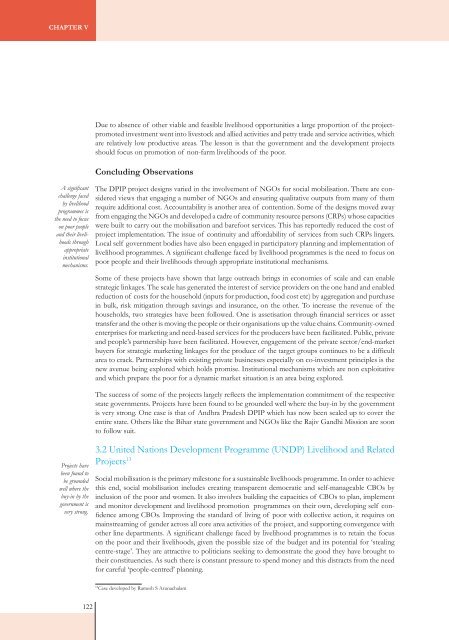SOIL Report 2008 - ACCESS Development Services
SOIL Report 2008 - ACCESS Development Services
SOIL Report 2008 - ACCESS Development Services
You also want an ePaper? Increase the reach of your titles
YUMPU automatically turns print PDFs into web optimized ePapers that Google loves.
Chapter VDue to absence of other viable and feasible livelihood opportunities a large proportion of the projectpromotedinvestment went into livestock and allied activities and petty trade and service activities, whichare relatively low productive areas. The lesson is that the government and the development projectsshould focus on promotion of non-farm livelihoods of the poor.Concluding ObservationsA significantchallenge facedby livelihoodprogrammes isthe need to focuson poor peopleand their livelihoodsthroughappropriateinstitutionalmechanisms.The DPIP project designs varied in the involvement of NGOs for social mobilisation. There are consideredviews that engaging a number of NGOs and ensuring qualitative outputs from many of themrequire additional cost. Accountability is another area of contention. Some of the designs moved awayfrom engaging the NGOs and developed a cadre of community resource persons (CRPs) whose capacitieswere built to carry out the mobilisation and barefoot services. This has reportedly reduced the cost ofproject implementation. The issue of continuity and affordability of services from such CRPs lingers.Local self government bodies have also been engaged in participatory planning and implementation oflivelihood programmes. A significant challenge faced by livelihood programmes is the need to focus onpoor people and their livelihoods through appropriate institutional mechanisms.Some of these projects have shown that large outreach brings in economies of scale and can enablestrategic linkages. The scale has generated the interest of service providers on the one hand and enabledreduction of costs for the household (inputs for production, food cost etc) by aggregation and purchasein bulk, risk mitigation through savings and insurance, on the other. To increase the revenue of thehouseholds, two strategies have been followed. One is assetisation through financial services or assettransfer and the other is moving the people or their organisations up the value chains. Community-ownedenterprises for marketing and need-based services for the producers have been facilitated. Public, privateand people’s partnership have been facilitated. However, engagement of the private sector/end-marketbuyers for strategic marketing linkages for the produce of the target groups continues to be a difficultarea to crack. Partnerships with existing private businesses especially on co-investment principles is thenew avenue being explored which holds promise. Institutional mechanisms which are non exploitativeand which prepare the poor for a dynamic market situation is an area being explored.The success of some of the projects largely reflects the implementation commitment of the respectivestate governments. Projects have been found to be grounded well where the buy-in by the governmentis very strong. One case is that of Andhra Pradesh DPIP which has now been scaled up to cover theentire state. Others like the Bihar state government and NGOs like the Rajiv Gandhi Mission are soonto follow suit.Projects havebeen found tobe groundedwell where thebuy-in by thegovernment isvery strong.3.2 United Nations <strong>Development</strong> Programme (UNDP) Livelihood and RelatedProjects 13Social mobilisation is the primary milestone for a sustainable livelihoods programme. In order to achievethis end, social mobilisation includes creating transparent democratic and self-manageable CBOs byinclusion of the poor and women. It also involves building the capacities of CBOs to plan, implementand monitor development and livelihood promotion programmes on their own, developing self confidenceamong CBOs. Improving the standard of living of poor with collective action, it requires onmainstreaming of gender across all core area activities of the project, and supporting convergence withother line departments. A significant challenge faced by livelihood programmes is to retain the focuson the poor and their livelihoods, given the possible size of the budget and its potential for ‘stealingcentre-stage’. They are attractive to politicians seeking to demonstrate the good they have brought totheir constituencies. As such there is constant pressure to spend money and this distracts from the needfor careful ‘people-centred’ planning.13Case developed by Ramesh S Arunachalam122














